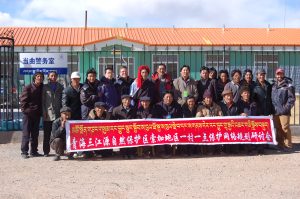Yaghnob Valley in northern Tajikistan is a region known for its unique mountain biodiversity and the cultural heritage of the Yaghnobi people. Following the establishment of Yaghnob National Park in 2019, the project focused on strengthening co-management between park authorities and local communities, recognising their central role in safeguarding both the landscape and local traditions. Project activities included wildlife surveys using camera traps—documenting snow leopard, lynx, ibex, bears, and many other mammals as well as birds—while building the skills of park rangers and community members to continue long-term monitoring. The project also supported sustainable livelihood development through trail mapping, information boards, yurt-based tourism initiatives, and training events that help residents benefit from responsible tourism.
Additional components touched on education and awareness, particularly among Yaghnobi youth, and strengthening park governance through management recommendations, capacity building. Together, these efforts offered a holistic approach integrating ecological and cultural continuity along with community development in one of Central Asia’s most remarkable mountain valleys.
Yagnob Project by Plateau Perspectives on Exposure href=”https://exposure.co” style=”text-transform:uppercase”>Exposure
Central Asian countries sit at the heart of this flyway. Their wetlands, steppe lakes, river deltas, and grasslands function as irreplaceable mid-route refuges where birds rest, refuel, and recover during long migrations. Because these sites determine whether many species successfully complete their journeys, the region plays an outsized role in the stability of the entire flyway.
As pressures from habitat loss, climate change, and growing human disturbance increase, coordinated conservation efforts across Central Asia are essential to maintain the ecological connectivity that migratory birds depend on throughout their annual cycles.


Local herders have been protecting wildlife including snow leopard, Tibetan wild ass (kiang), Tibetan antelope and black-necked cranes in the Yangtze River headwaters through community conserved areas formally established in 1998. These protected areas initially were recognized by the district government, and subsequently also by the Sanjiangyuan Nature Reserve managed under the Qinghai Forestry Department. The grassroots NGO Upper Yangtze Organization also was established in 1998, and has been instrumental in the development of community-based conservation and development in the region since that time.
 Working in partnership with nature reserve management authorities since 2005, Plateau Perspectives has supported the development and trialling of community co-management. Community members and staff of the nature reserve’s Suojia field station embarked together on the first co-management trial in the region in 2009, jointly focusing their attention on monitoring snow leopard with the use of camera traps, in snow leopard habitat around 5000 metres above sea level. This collaborative work yielded some of the first snow leopard photos in the region.
Working in partnership with nature reserve management authorities since 2005, Plateau Perspectives has supported the development and trialling of community co-management. Community members and staff of the nature reserve’s Suojia field station embarked together on the first co-management trial in the region in 2009, jointly focusing their attention on monitoring snow leopard with the use of camera traps, in snow leopard habitat around 5000 metres above sea level. This collaborative work yielded some of the first snow leopard photos in the region.
Community co-management approaches are now mainstreamed in Qinghai province, through projects such as the UNDP/GEF-supported ‘Strengthening the effectiveness of the protected area system‘ project implemented by the Qinghai Forestry Department.
Publications:


 Working in partnership with nature reserve management authorities since 2005, Plateau Perspectives has supported the development and trialling of community co-management. Community members and staff of the nature reserve’s Suojia field station embarked together on the first co-management trial in the region in 2009, jointly focusing their attention on monitoring snow leopard with the use of camera traps, in snow leopard habitat around 5000 metres above sea level. This collaborative work yielded some of the
Working in partnership with nature reserve management authorities since 2005, Plateau Perspectives has supported the development and trialling of community co-management. Community members and staff of the nature reserve’s Suojia field station embarked together on the first co-management trial in the region in 2009, jointly focusing their attention on monitoring snow leopard with the use of camera traps, in snow leopard habitat around 5000 metres above sea level. This collaborative work yielded some of the